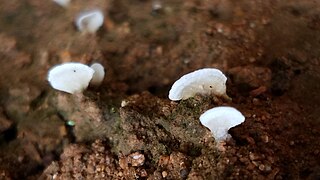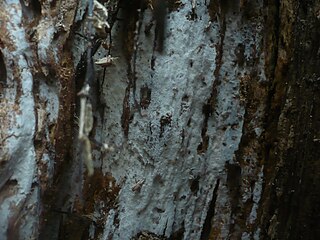
The Hygrophoraceae are a family of fungi in the order Agaricales. Originally conceived as containing white-spored, thick-gilled agarics, including Hygrophorus and Hygrocybe species, DNA evidence has extended the limits of the family, so it now contains not only agarics, but also basidiolichens and corticioid fungi. Species are thus diverse and are variously ectomycorrhizal, lichenized, associated with mosses, or saprotrophic. The family contains 34 genera and over 1000 species. None is of any great economic importance, though fruit bodies of some Hygrocybe and Hygrophorus species are considered edible and may be collected for sale in local markets.

Cyphellostereum is a genus of basidiolichens. Species produce white, somewhat cup-shaped fruit bodies on a thin film of green on soil which is the thallus. All Cyphellostereum species have nonamyloid spores and tissues, lack clamp connections, and also lack hymenial cystidia.
Acantholichen is a fungal genus in the family Hygrophoraceae. The genus was circumscribed by Norwegian lichenologist Per Magnus Jørgensen to contain the type, and at that time, only species, the basidiolichen Acantholichen pannarioides, discovered originally in Costa Rica in 1998. This species has a bluish, gelatinous thallus, and a fine, white powdery bloom covering the hairy upper surface; this surface is said to resemble "an unshaven chin". Five additional species, all basidiolichens, were added to the genus in 2016 following an in-depth analysis of specimens collected from the Galápagos, Costa Rica, Brazil and Colombia.
Dictyonema is a genus of mainly tropical basidiolichens in the family Hygrophoraceae.

Muscinupta is a fungal genus that produces small white delicate fan-shaped to cupulate fruitbodies on mosses. It is monotypic, containing the single species Muscinupta laevis. The type species is better known under the name Cyphellostereum laeve but Cyphellostereum is a basidiolichen.
Dictyonema hernandezii is a species of basidiolichen in the family Hygrophoraceae. Found in montane rainforests of Costa Rica and in Colombia, it was described as new to science in 2011. The specific epithet hernandezii honours Venezuelan lichenologist Jesús Hernández.
Cora hirsuta is a species of basidiolichen in the family Hygrophoraceae. Found in the páramo region near Bogotá at over 3,000 m (9,800 ft) elevation, it was described as new to science in 2011. The lichen, characterised by its distinctively hairy upper surface and smaller lobes, thrives in a variety of habitats, including soil, bryophytes, and as epiphytes on trees.

Eonema is a fungal genus in the family Hygrophoraceae. It is monotypic, consisting of the single corticioid species Eonema pyriforme. This fungus was previously classified in the genus Athelia until molecular analysis demonstrated that it was unrelated to the Atheliales and instead nested within the Hygrophoraceae.

Cora is a large genus of basidiolichens in the family Hygrophoraceae. Modern molecular phylogenetics research has revealed a rich biodiversity in this largely tropical genus.
Cora arachnoidea is a species of basidiolichen in the family Hygrophoraceae. Found in Venezuela, it was formally described as a new species in 2013 by Jesús Hernández and Robert Lücking. The type specimen was collected in the surroundings of Laguna de Mucubají, at an altitude of 3,626 m (11,896 ft). The specific epithet makes reference to the arachnoid (cobwebby) texture of the thallus surface. Another member of the genus with a similar surface is Cora hirsuta.
Cora byssoidea is a species of basidiolichen in the family Hygrophoraceae. Found in Colombia, it was formally described as a new species in 2013 by lichenologists Robert Lücking and Bibiana Moncada. The type specimen was collected in Páramo El Verjón at an altitude of 3,200 m (10,500 ft). Here it was found growing as an epiphyte on twigs and small branches of páramo vegetation. The lichen is only known from the type locality. The specific epithet byssoidea refers to the byssoid surface of the upper thallus. This surface comprises an irregularly dissolved layer of single hyphae in the cortex. A lookalike species, Cora hirsuta, also found at the same location, has a similar surface texture. In this lichen the surface is made of erect trichomes of agglutinated hyphae; despite their similarities, the two species are not closely related.
Cora cyphellifera is a species of basidiolichen in the family Hygrophoraceae. Found in northern Ecuador, it was formally described as a new species in 2013 by Manuela Dal-Forno, Frank Bungartz, and Robert Lücking. The type specimen was collected near the entrance to the Alto Choco Reserve at an elevation of 2,053 m (6,736 ft). Here, in open, disturbed forest patches, the lichen grows as an epiphyte on tree branches and twigs, forming foliose, light bluish-green thalli up to 15 cm (6 in) across, and comprising 20 to 30 semicircular lobes in each thallus. Cora cyphellifera is only known to occur at the type locality, which is a montane rainforest. The specific epithet refers to the unusual cyphelloid structure of the thallus; this characteristic is otherwise unknown in the genus Cora. According to the authors, "it almost looks like the lichenized thallus is parasitized by a non-lichenized, cyphelloid mushroom".
Cora strigosa is a species of basidiolichen in the family Hygrophoraceae. Found in Peru, it was formally described as a new species in 2013 by Robert Lücking, Elias Paz, and Luis Salcedo. The type specimen was collected in Piscacucho at an altitude of about 2,700 m (8,900 ft). Here, in montane rainforest and pasture near Machu Picchu, the lichen grows on rocks together with other lichens, such as Hypotrachyna and Rimelia. Cora strigosa is only known to occur at the type locality. The specific epithet strigosa refers to the strigose upper surface of the thallus, especially prominent where they project radially at the margins. This lichen resembles Cora hirsuta, but it is not closely related.
Acantholichen albomarginatus is a species of basidiolichen in the family Hygrophoraceae. Found in Brazil, it was formally described as a new species in 2016 by Manuela Dal-Forno, Marcelo Marcelli, and Robert Lücking. The type specimen was collected in Estrada das Prateleiras at an altitude of 2,190 m (7,190 ft). Here, on the edge of a cloud forest in dense vegetation on the side on the road, it was found growing amongst bryophytes and liverworts. The specific epithet albomarginatus, which combines the Latin roots albo- ("white") and marginatus ("edge"), refers to the white margins that are on some of the squamules. The lichen is only known to occur at the type locality, which is part of the Atlantic Forest biome. The authors suggest that the species is easily overlooked, "because from a distance it looks like a mass of bluish gray hyphae resembling a non-lichenized cyanobacterium or just developing hyphae".
Acantholichen campestris is a species of basidiolichen in the family Hygrophoraceae. Found in Brazil, it was formally described as a new species in 2016 by Manuela Dal-Forno, Adriano Spielmann, and Robert Lücking. The type specimen was collected in Campos do Quiriri at an altitude of 1,380 m (4,530 ft). Here, at the top of the mountain on exposed rocky outcrops, it was found growing on rocks growing amongst liverworts and other lichens. The specific epithet, which contains the Latin word campis, refers to the habitat of the lichen. Acantholichen campestris is the only member of the genus which, instead of growing on bark, overgrows lichens and liverworts that inhabit rock.
Acantholichen galapagoensis, commonly known as the Galapagos spiny gladiator lichen, is a species of basidiolichen in the family Hygrophoraceae. Found in the Galápagos Islands, it was formally described as a new species in 2016 by Manuela Dal-Forno, Frank Bungartz, and Robert Lücking. The type specimen was collected in Isla Santa Cruz at an elevation of 684 m (2,244 ft). Here in a dense forest of Cinchona pubescens it was found growing over Frullania liverworts. The specific epithet refers to its type locality.
Acantholichen sorediatus is a species of basidiolichen in the family Hygrophoraceae. Found in Costa Rica, it was formally described as a new species in 2016 by Manuela Dal-Forno, Harrie Sipman, and Robert Lücking. The type specimen was collected from the Las Cruces Biological Station at an altitude of 1,200 m (3,900 ft); this area is part of the Cordillera Central. Here, in the undergrowth of a disturbed primary forest, it was found growing on a tree trunk along with other lichens, including Hypotrachyna, Normandina, and Leptogium. The specific epithet refers to the soredia, found along the margins of the squamules.
Acantholichen variabilis is a species of basidiolichen in the family Hygrophoraceae. Found in Colombia, it was formally described as a new species in 2016 by Manuela Dal-Forno, Luis Fernando Coca, and Robert Lücking. The type specimen was collected in Cerro San Antonio at an elevation of 1,946 m (6,385 ft). Here, on the edge of a montane wet forest, the lichen was found growing on moss in an area with high light intensity. The specific epithet refers to the variable size of the acanthohyphidia in the lichen. The species is only known from the type locality. Acantholichen albomarginatus is also found at this location.
Dictyonema aeruginosulum is a species of basidiolichen in the family Hygrophoraceae. Characteristics of the lichen include its distinctive finger-like projections and blue-green hue. It is distinguishable from its closest relatives by its unique morphology and the absence of clamp connections in its structure. Dictyonema aeruginosulum is an epiphyte, forming thick mats on tree trunks within rainforest regions. The species was first identified in Costa Rica's Tenorio Volcano National Park, and it has only been recorded from this location.
Dictyonema metallicum is a species of basidiolichen in the family Hygrophoraceae. It is found in the montane rainforests of Ecuador. Characterised by its metallic shimmer, it is an epiphytic lichen that spans large areas on host tree trunks and frequently extends to adjacent bryophytes. Its unique visual texture is created by the loosely interwoven dark blue fibrils of the thallus, a thin, compressed filamentous layer, accentuated by a silver prothallus.




